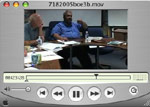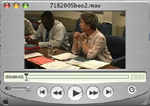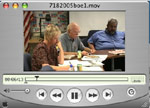Madison School Superintendent Art Rainwater via WisPolitics :
Thank you for making public education in Wisconsin a priority in the budget you presented to the Legislature – a proposal that protected Wisconsin’s overburdened property tax payers and the children of the state. Unfortunately, the budget before you resembles little of what you offered for our taxpayers and K-12 students.
Since the inception of state-imposed revenue limits in 1993, Madison has cut over $43 million in its “same-service” budget and eliminated almost 540 positions – including 121 positions for the 05-06 school year. It is disingenuous for Republican leaders to claim their $458 million school aid increase as “historic,” when over 90 percent of the resources are targeted for school property tax relief, not for school programs and services. We have long surpassed cutting fat from our local budget, but have cut into bone as we increase class size in secondary instruction, eliminate classroom opportunities for students and cut support staff who assist our most needy students and families.
I urge you to use your veto authority to the fullest extent in order to restore revenue limit increases that keep pace with inflation, versus the GOP plan that cuts the allowable increase to 1.4 percent – less than half of the current inflation rate. Aside from increases in categorical aids, the revenue limit increase represents a school district’s only opportunity to fund critical programs for students.
I’m glad the Superintendent sent his comments to the Governor. It will be interesting to see where the Governor, facing a 2006 election campaign, lands on the amount of increased spending for Wisconsin schools (the battle is over the amount of increased money: the Republican budget includes a 458M increase to the 5.3B base, while Governor Doyle originally proposed a $900M increase via borrowing and other shifts).
Madison is also somewhat unique in this discussion in that about 25% of its budget comes from the State (State school spending will go up faster than inflation, in either case. The puzzle for me is the 1.4% that Superintendent Rainwater refers to. Is this due to Madison’s flat enrollment and/or based on the formulaic penalty we face for our higher than average per student spending? The enrollment situation is sort of strange, given the housing explosion we’ve seen over the past 10 years), whereas other districts receive a much higher percentage of their budget from state taxpayers. Further, Madison taxpayers have supported a significant increase in local school support over the past decade. The District’s Operating Budget has grown from $200M in 1994-1995 to $317M in 2005-2005. Art’s letter mentions “cut $43 million in its “same-service” budget and eliminated almost 540 positions – including 121 positions for the 05-06 school year”. There’s also been some discussion here about District staffing changes.
I also believe the District needs to immediately stop operating on a “same service approach”. Given the rapid pace of knowledge and information change today (biotech, science, engineering among others) AND the global challenges our children face (Finland, India, China and other growing economies – see Thomas Friedman’s The World is Flat) things that worked over the past decade may no longer be practical or affordable for that matter.
Having said all that, it is difficult to manage anything when the curveballs are coming rather quickly. It would be great for the state to be consistent in the way it provides funds for 25% of our District’s budget. Similarily, in the private sector, many would love to see less risk and change, but I don’t see it happening.



